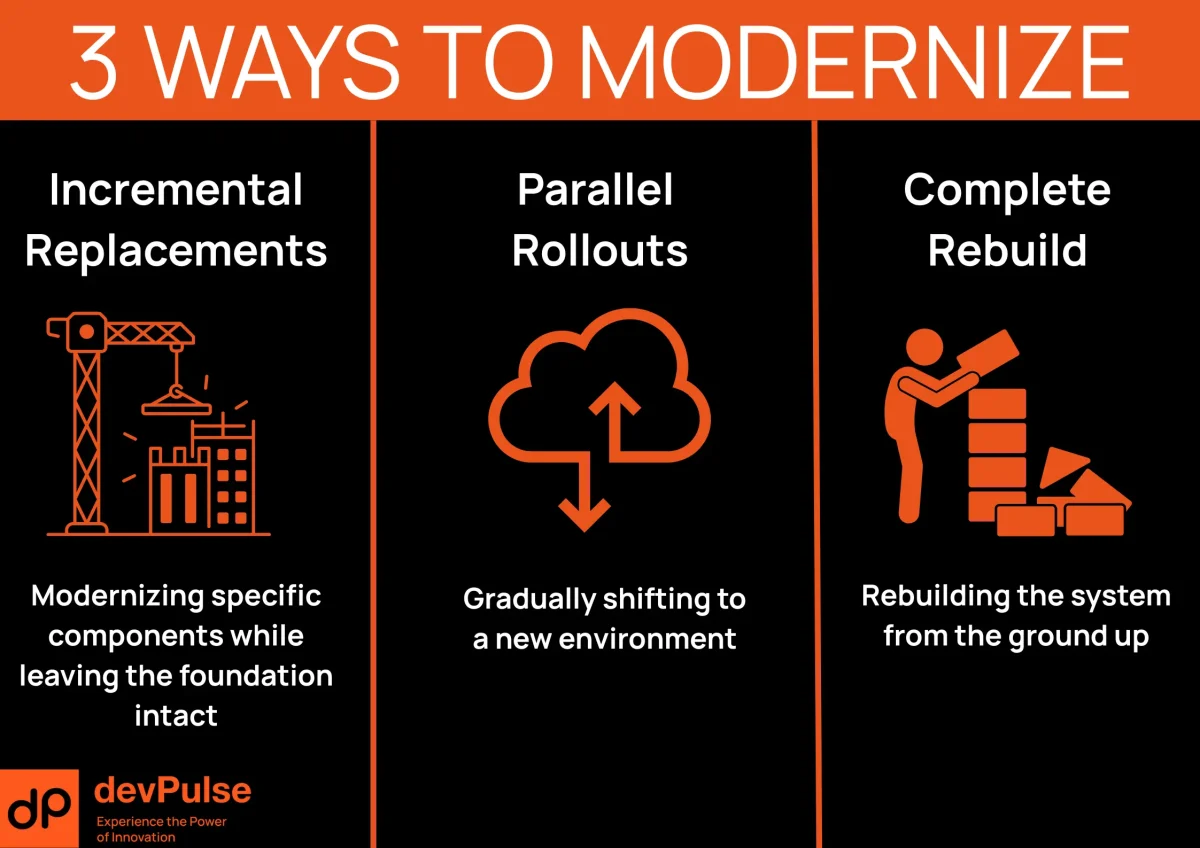Updated March, 2025
Outdated technology often drains more resources than we realize. Legacy software can erode efficiency, block modern integrations, and even introduce extra security risks. Legacy system modernization-the process of updating or overhauling aging applications-offers a path to sustained agility and resilience. But rather than framing it as an all-or-nothing choice, let’s explore measured strategies that help you update core infrastructures without upending your entire operation.
Why Modernize Now?
Ignoring aging tech has a way of creating hidden costs. On the surface, legacy platforms might still “get the job done,” but behind the scenes, your team often juggles countless manual workarounds and contends with performance bottlenecks. Over time, support for older frameworks dwindles, making bug fixes or security patches harder (and pricier) to implement. Delaying modernization can even limit how quickly you adapt to new market demands or regulatory changes.
If you’re planning a broader transformation, a clear parallel emerges between modernization and digital transformation in general. By realigning processes with the demands of cloud-based tools, data-driven decision-making, and rapid iteration, you ease the transition toward a more digitally mature organization. In fact, a wider digital transformation guide for 2025 may help you see how legacy upgrades fit into a long-term strategy.
Recognizing the True Costs of Doing Nothing
When a system is so familiar that employees “just deal with it,” it’s easy to overlook its effect on daily operations. Legacy applications frequently rely on older programming languages or outmoded infrastructure that frustrates integration with modern cloud services. Manual data entry becomes a constant grind, and security concerns-like patching vulnerabilities that are no longer actively supported-become urgent.
Alongside these challenges, you might miss opportunities to automate routine tasks or gather insights from your business data. By contrast, companies that invest in modernization often find it easier to adopt DevOps best practices, rolling out software updates in hours instead of weeks. As a result, teams gain momentum and reduce the risk of last-minute surprises. If continuous delivery is part of your plan, you might find our DevOps Implementation Guide for 2025 provides complementary insights to streamline deployment in tandem with your modernization efforts.
A More Thoughtful Perspective on Modernizing
Rather than painting modernization as a dramatic overhaul with looming do-or-die stakes, let’s break it down into clearer paths:
- Incremental Replacements.
In some cases, modernizing specific components-like upgrading your middleware or rewriting the interface-can alleviate the biggest pain points. You target high-impact changes while leaving stable back-end elements intact. This approach is less disruptive, though it demands careful planning to ensure the old and new pieces communicate seamlessly. - Parallel Rollouts.
You introduce a fresh environment (perhaps a new cloud-based platform or a containerized service) and gradually shift data and users from the legacy system. This keeps downtime minimal and offers real-world testing without abruptly retiring the old infrastructure. If you’re particularly interested in cloud migrations, our cloud migration strategy article explores phased approaches that can dovetail well with parallel modernization.
Complete Rebuild.
Although more ambitious, a rebuild may be justified if your system is so outdated that piecemeal improvements end up even more costly. This scenario often includes adopting a modern tech stack with microservices architecture or serverless functions. The rewards can be immense-better performance, easier scalability-but you’ll need a solid roadmap to avoid project sprawl.

A Word on Implementation Frameworks
Industry references to “the 7 Rs” (e.g., Rehost, Refactor, Rearchitect) provide a structured vocabulary for modernization. Whether you follow a formal methodology or a more intuitive approach, clarity about your end goals helps the entire organization align on priorities and timeline.
Beyond Bullets: A More Narrative Look at the Benefits
Modernization is about more than chasing the next tech trend. Here’s how it can reshape your business:
- Operational Efficiency: Refreshing (or replacing) core software can cut down on redundant processes that have accumulated over years. Rather than letting staff spend hours on manual data transfers, you can connect systems directly, often using APIs designed for modern platforms.
- Security and Compliance: Older applications often lack key features-like robust encryption or multi-factor authentication. Updating codebases and frameworks brings your environment closer to current security standards. In regulated industries, compliance audits become smoother, which is crucial for stability and reputation.
- Easier Iteration and Integration: Tech evolves quickly. A flexible, modern architecture opens the door to iterative improvements and better alignment with Agile transformation practices. If you want to adopt a new e-commerce tool or spin up a data analytics service, you’re not hamstrung by outdated protocols.
- Improved Employee & Customer Experience: Many legacy systems feature clunky interfaces and limited self-service options. Redesigning with a user-first approach (drawing on UX/UI best practices) can streamline how employees interact with critical data and workflows. Even customers may notice smoother interactions, from real-time inventory checks to faster account servicing.
- Data-Driven Insights: When vital information isn’t fragmented across siloed legacy databases, you’re free to harness analytics more effectively. This can mean predicting demand spikes, tracking fulfillment metrics in real time, or discovering hidden correlations in your sales pipeline. Organizations adopting digital process automation often see how clean, connected data drives more strategic planning.
A Pragmatic Framework for Success
Many successful modernization efforts follow a broad, repeatable framework. Each step offers clarity and ensures you’re addressing core problems rather than layering on new tech arbitrarily.
1. Assessment & Roadmapping
Survey your existing software, hardware, and workflows to see where the most pressing issues lie. Document relevant dependencies and consider whether you have existing in-house skills-or whether a specialized partner might help. This initial discovery sets the stage for deciding how aggressively you should modernize.
2. Targeted Upgrades
Rather than tackling everything simultaneously, focus on the areas with the greatest potential ROI. It might be a customer-facing portal that’s slowed by dated architecture, or a back-end integration that complicates daily operations. Upgrading these critical points first can yield quick wins and build momentum.
3. Collaboration & Governance
Bringing cross-functional teams together prevents miscommunication about timing, budget, or deliverables. When teams collaborate early-possibly adopting a DevOps or Agile mindset-they can iterate more quickly on prototypes and handle issues before they become major obstacles.
4. Testing & Rollout
Testing should reflect real-world conditions. For instance, if your modernization involves cloud hosting, test network latency and failover scenarios. If you’re rewriting parts of a monolithic app, confirm that data integrity remains intact with every update. Roll out new elements in stages to mitigate risk and keep user disruption minimal.
5. Ongoing Refinement
Modernization rarely ends with a single “go-live.” Continual refinements-like improving user interface flows or introducing new integrations-can sustain the benefits. This might tie closely to overall digital transformation ambitions, where the modernized system becomes the foundation for bigger strategic shifts.
A Realistic Example: Engaging in Parallel Transition
Imagine a mid-sized distributor relying on a 12-year-old inventory tracking application. That software can’t easily communicate with cloud-based order management systems, so employees are forced to download CSV files daily and manually reconcile data. By setting up a parallel environment-a new, modern solution that periodically syncs with the legacy system-the distributor can incrementally move product lines and staff workflows to the updated platform. This transition allows for real-world testing and training without abruptly flipping a switch on day one. Once feedback confirms the new environment works reliably, the old system can be gradually decommissioned.
Common Stumbling Blocks & How to Navigate Them
- Underestimating Data Complexity: Older applications may store data in proprietary formats or require manual scripts to export. Allocate time for robust data cleansing, mapping, and migration.
- Overlooking End-User Adoption: Even the best replatforming project falters if users resent a new interface. Early engagement and training, coupled with an intuitive design, are essential for buy-in.
- Lack of Clear Goals: If the team doesn’t know how you’ll measure success-fewer errors, faster transaction times, reduced downtime-it’s hard to judge whether modernization made a difference.
- Security Gaps in New Integrations: Upgrading can introduce new vulnerabilities if you haven’t implemented modern authentication, encryption, or patch policies.
Concluding Thoughts: A Steady Path Forward
Legacy system modernization is not simply an “upgrade or else” proposition. It’s a step toward sustainable growth, practical efficiency gains, and a stronger alignment with modern security standards. Rather than framing it as a stark binary, look at your current bottlenecks, your team’s capacity, and your future goals. Then chart a path that addresses today’s needs while leaving room to evolve.
By methodically phasing in updates, staying mindful of end-user experiences, and building on each success, you can transform a creaking technical foundation into a flexible, future-ready platform. Above all, keep in mind that modernization is not the finish line but a continuous practice, one that positions your organization to meet new demands without getting caught on the back foot.
If you’re weighing larger-scale projects-like rethinking your entire software portfolio or adopting advanced approaches such as container orchestration-consider how modernization meshes with your overall modern tech stack roadmap. Taking each incremental step in harmony ensures your business runs more smoothly in the present and remains nimble enough to pivot when the next wave of technology arrives.
It depends on how quickly you need results and how stable your current environment is. Incremental upgrades can address pressing issues fast, but a full rebuild may be warranted if the legacy system is truly unfit for long-term needs.
Modernization is at least as much about process and culture. It helps to align stakeholders, develop new workflows, and even reevaluate your approach to software delivery. If you’re also embracing cloud or containerization, you may discover you need new internal policies on release management and quality assurance.
Consider targeting the most painful or expensive constraints first. Demonstrating tangible ROI on a smaller scope often wins support for subsequent improvements.
Agile and DevOps can help teams adapt quickly, reduce bottlenecks between development and operations, and test in shorter cycles. That’s especially useful if your modernization involves frequent releases or significant code refactoring.





